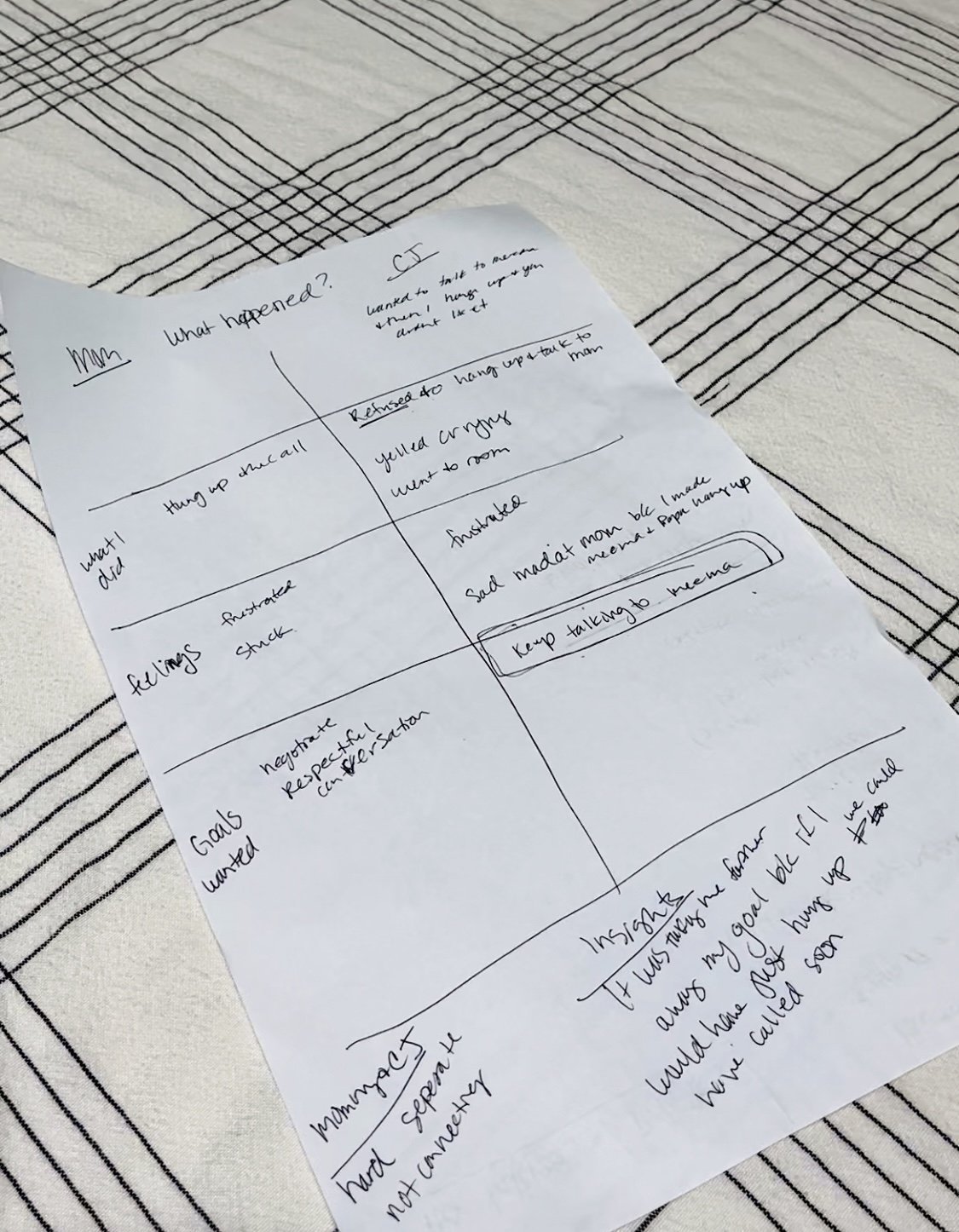Problem Solving through a Power Struggle
Let’s face it.
Power struggles are tricky.
You and your child clearly have different goals and perspectives, and you both have strong feelings.
This story is about the first time I used Reflective Problem Solving to help me navigate a power struggle with my son, CJ.
I’ll never go back.
Finally, a process that allows my son to feel heard AND me to feel heard too!
I hope this helps you.
–Dr. Cline
P.s., Since this challenge, I created a Kid-Friendly Problem Solving Chart for you! Get it here.
Problem Solving through a Power Struggle
Today I’m sharing a story from my own parenting life about how Hourglass Problem Solving helped me diffuse a power struggle with my son and got us both to a mutually satisfying solution.
In other words, I’m sharing a problem solving tool you can use with children!
My son CJ was six years old at the time. His favorite person in the world is his Meema (my mom), and they connect over FaceTime a lot because we live in South Carolina and my parents live in Minnesota.
Transitions are hard for many kids, including mine.
CJ does not want to say goodbye or stop what he’s doing.
He can kind of turn into a wild animal who’s being trapped. He has screamed, kicked, and run away because he’s not ready for whatever he’s doing to come to an end. It’s not extreme every time but I want you to get into CJs head and know that when something is ending before he’s ready it’s really painful for him.
The other weekend CJ was on FaceTime with his Meema and Papa. They were on the call for a long time, probably at least an hour or more, and it was time for us to get ready to leave the house to run some errands. They were not things he was excited about and he’s the kind of kid who would love to stay in his room with his toys and his imagination all day on Saturday because he’s been gone all week at school. So, running errands is far from his ideal Saturday (mine either).
We had already talked through the day. He knew what to expect but when it was actually time to say goodbye to Meema he was not having it. He started running away into other rooms and trying to hide with the iPad.
I did my best to stay calm but inside I wasn’t sure how to handle the situation.
I didn’t want to yell at him or force the iPad away from him. And I didn’t want it to keep escalating with my parents sitting there not knowing what to do. So, I ended up asking my mom to hang up the call. That was hard because I know they don’t like to do that to CJ and this issue was between him and I, but I couldn’t reach the iPad so I asked for their help.
Understandably, CJ was very upset by this. He yelled and stormed off into his room.
I gave him space because I know he’s a kid who calms down better on his own and then comes back to talk about it.
Though “talking about it” usually means him repeating his feelings a lot and us going in circles a bit.
When he came back, I wasn’t quite sure how to move forward in a way that didn’t just force one of us to give in and not get what we wanted.
Then, out of the corner of my eye I noticed a blank piece of paper and pen.
I grabbed it and started drawing out the processing form that I use with parents when they’re feeling stuck.
I called it a problem solving chart and asked him if we should use it to help us figure out how to solve our problem.
He went for it and I started with our first general question, “What happened?”
I wrote down that CJ wanted to talk to Meema and then I hung up and he didn’t like it. He agreed with that description and we kept moving forward. The next two rows were for actions and feelings but I ended up jumping down to goals first because I knew it was already said–he wanted to keep talking to his Meema. CJ agreed and watched me write it down under his name but four rows down.
Then he said, “what about those spaces?” And pointed to the two blank squares under actions and goals. That’s when a light bulb went off for me.
It’s a visual chart!
Visual charts are so helpful for children!
Why had I never thought of this before?!!
I had to return to the moment and be a mom so I told him those spaces were for writing down what we did and how we felt. We went through them together and since we both had our own columns we each got to share and honor our feelings.
CJ got to say that he was sad and mad at mom because I made Meema and Papa hang up. He got to see me validate his feelings by writing down exactly what he expressed.
He didn’t keep repeating himself like he usually does! Did this help him feel heard in a way he hadn’t before? I was fascinated.
Then, I got to share that I was feeling frustrated because we had already made a plan for the day earlier and he wasn’t sticking to it. And I felt stuck because I didn’t want to force his conversation to end.
I noticed that we were both sharing honestly about our feelings but we were also both calm and listening to each other.
What was really cool is when we moved further through the Hourglass, to talk about implications, I asked him how he thought his actions worked for his goals. In other words, I could use the chart to point out that what he wanted was to keep talking to his Meema. What he did was refuse to hang up. That did not actually meet his goal because I asked my mom to hang up. I let CJ know that I was open to negotiating more time for him but not when he was refusing to figure it out together.
CJ realized that his actions didn’t help him meet his goal and he had me write down “It was taking me further away from my goal because If I would have just hung up we could have called back sooner.”
That’s an impressive insight for a child–to become aware of how your actions moved you away from your goal.
And it was the visual chart that helped him get there.
Another question I asked was how the interaction impacted our relationship. We were both able to recognize that the interaction was hard and caused separation. We were not connecting. We agreed that this was not the kind of relationship either of us wanted, so we could think together about what kind of relationship we did want and how we could move forward in a way that matched that.
We easily made a plan to get ready and then CJ could call his Meema back while we were driving. What’s funny is that by the time he got into the car he didn’t need to call her back. He was ready to move on with the day.
This is an example of how the problem is not the problem, which is part of my philosophy of practice (and parenting).
Oh and I forgot about the sweetest moment. When we got done writing in the chart we had a lovely hug and then he asked if he could keep the problem solving chart! He actually took it to his room and still has it. He let me take a picture of it for you but isn’t that so sweet? I think it says something about how he felt seen, heard, and connected through that exercise and wanted to take that memento with him.
We had a great rest of our day together and didn’t have other conflicts of note.
There you have it.
The idea for a kid-friendly problem solving chart is born!
Here’s a re-cap of the benefits for you and your kiddo:
Diffuses power struggle
Everyone feels seen and heard
Find a mutual solution together
Connect!
Develop shared language for next time
Helps kiddos develop skills in:
Seeing how behavior impacts goals
Empathy and perspective-taking
Thoughtful, productive problem-solving
Appropriately expressing feelings and needs
How would these skills support your child’s development and your parenting life?
But wait, there’s one more piece to this story that I think is important to share.
The next day we were at a friend's house. CJ was having so much fun playing and did not want to leave. We were standing in the garage and I noticed him take off to run away into the house - presumably to hide and refuse to transition. Are you seeing a theme here?
I said, “CJ remember, that’s not going to get you what you want.”
I watched him stop at the door, turn and look at me and walk back to us, surrendering to the reality that it was time to go.
The rest of the transition was smooth and he wasn’t upset.
I asked him later that night about that moment and he said that he remembered the chart we made the other day and knew that running away wasn’t going to get him what he wanted. So he stopped himself.
I was able to tell him how proud I was of him and I could tell he was proud of himself.
I captured our conversation on video. Here it is.
CJ remembered to change his behavior/make a different choice because of Hourglass Problem Solving. Here’s why:
Taking notes on the visual chart stores the new learning, lessons, or agreements in more places than short term memory (which is usually forgotten right after you remind them, yet again).
Creating the connection for actions, goals, feelings, and outcomes helps them/us make more intentional future choices.
The specific flow of questions are designed to draw out new, internal insights. Since CJ discovered his own insight, he didn’t need to remember what his mom told him to do. He simply connected with his own internal wisdom.
Wisdom can’t be told. But it can be cultivated through Hourglass Problem Solving.
UPDATE! You can now download your own chart!
After that experience, I created a Kid-Friendly Problem Solving Chart so that you could also navigate power struggles with your child(ren) in a way that helps you connect, solve the problem, and support their development.
Hourglass Problem Solving helps bring productive empathy into any power struggle or challenge.
It’s been a game changer for my family and I can’t wait to hear how it supports you.



